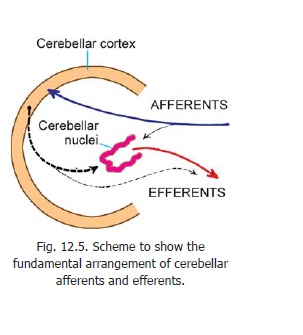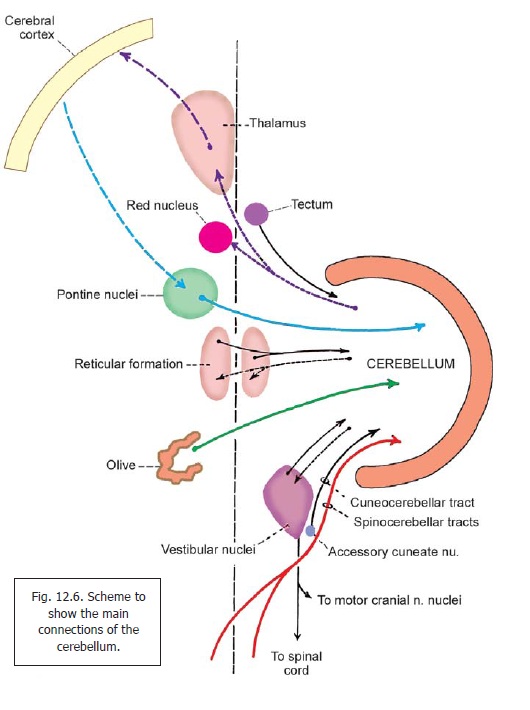Chapter: Human Neuroanatomy(Fundamental and Clinical): Internal Structure of Cerebellum
Main Connections of the Cerebellum
Main Connections of the Cerebellum
The fundamental points to be appreciated in considering the connections of the cerebellum are that, as a rule (Fig. 12.5):

1. afferent fibres terminate in the cortex;
2. efferent fibres arising in the cortex end in cerebellar nuclei; and
3. fibres arising in the nuclei project to centres outside the cerebellum.
There are, however, important exceptions to these rules. Some fibres (notably vestibular) project directly to the cerebellar nuclei. Some parts of the cortex give off efferents that bypass the nuclei to reach centres outside the cerebellum.

The cerebellum receives direct afferents from the spinal cord and from various centres in the brainstem. The main afferents are (Fig. 12.6):
1. Spinocerebellar. These terminate predominantly inthe paleocerebellum
2. Pontocerebellar. These are part of the cortico-ponto-cerebellar pathway. They endpredominantly in the neocerebellum.
3. Olivocerebellar. These end mainly in the neocerebellum and partly in the paleocerebellum.
4. Vestibulocerebellar, from the vestibular nuclei, and also direct fibres of the vestibular nerve
5. Reticulocerebellar fibres from the reticular formation of the pons and of the medulla.
The cerebellum also receives fibres from the tectum, the arcuate nuclei, the accessory cuneate nucleus, and from the sensory nuclei of the trigeminal nerve.
1. Cerebellorubral, to the red nucleus of the opposite side.
2. Cerebellothalamic, to the thalamus of the opposite side.
3. Cerebellovestibular, to thevestibular nuclei.
4. Cerebelloreticular, to the reticularformation.
Some fibres from the cerebellum also reach the inferior olivary nucleus, the nucleus of the oculomotor nerve, and the tectum.
Cerebellar peduncles
Some features of cerebellar peduncles have been described. The various fibres entering or leaving the cerebellum pass through the superior, middle and inferior cerebellar peduncles. These connect the cerebellum to the midbrain, the pons and the medulla respectively The fibres composing each peduncle are enumerated below.
SUPERIOR CEREBELLAR PEDUNCLE
Fibres entering the cerebellum
a. Ventral spino-cerebellar tract.
b. Rostral (or superior) spino-cerebellar tract.
c. Tecto-cerebellar fibres.
d. Rubro-cerebellar fibres.
e. Trigemino-cerebellar fibres, from mesencephalic nucleus.
f. Hypothalamo-cerebellar fibres.
g. Coerulo-cerebellar fibres. These are noradrenergic fibres from the nucleus coeruleus.
Fibres leaving the cerebellum
a. Cerebello-rubral fibres.
b. Cerebello-thalamic fibres. Cerebellorubral and cerebellothalamicfibres arise from the dentate, emboliform and globose nuclei.
c. Cerebello-reticular fibres (from dentate nucleus, some from the fastigial nucleus).
d. Cerebello-olivary fibres (from dentate, emboliform and globose nuclei).
e. Cerebello-nuclear fibres. These enter the medial longitudinal fasciculus to reach motor nuclei ofnerves supplying the muscles of the eyeball.
f. Some fibres to the hypothalamus and subthalamus.
MIDDLE CEREBELLAR PEDUNCLE
This is made up of ponto-cerebellar fibres. Some serotoninergic fibres from the reticular formation of the pons also pass through it.
INFERIOR CEREBELLAR PEDUNCLE
Fibres entering the cerebellum
1. Posterior spino-cerebellar tract.
2. Cuneo-cerebellar tract (posterior external arcuate fibres).
3. Olivo-cerebellar fibres from the inferior olivary complex (including parolivocerebellar fibres from accessory olivary nuclei).
4. Reticulo-cerebellar fibres.
5. Vestibulo-cerebellar fibres.
6. Anterior external arcuate fibres from arcuate nuclei.
7. Fibres of striae medullares.
8. Trigemino-cerebellar fibres, from main sensory and spinal nuclei.
Fibres leaving the cerebellum
1. Cerebello-olivary fibres.
2. Cerebello-vestibular fibres.
3. Cerebello-reticular fibres (from fastigial nucleus).
4. Some cerebello-spinal and cerebello-nuclear fibres are also present.
Connections between Cerebellum and Spinal Cord
From a clinical point of view the most important connections of the cerebellum are with the spinal cord, and with the cerebral cortex. These connections are through various pathways that are summarised below.
Spinocerebellar pathways convey to the cerebellum proprioceptive information necessary for controlling muscle tone and for maintaining body posture. These pathways also carry exteroceptive impulses.
Direct pathways from spinal cord to cerebellum
These are the ventral spinocerebellar tract, and the dorsal spinocerebellar tract which convey information from the hind limb. Information from the forelimb is probably conveyed by the rostral spinocerebellar tract and the cuneocerebellar tract. The cuneocerebellar tract begins in the medulla, but is included here as it is functionally equivalent to spinocerebellar tracts.
Indirect pathways from spinal cord to cerebellum
These are:
(a) Spino-olivo-cerebellar;
(b) Spino-reticulo-cerebellar;
(c) Spino-vestibulo-cerebellar; and
(d) Spino-tecto-cerebellar pathways.
Although these are not concerned with the spinal cord it is useful to consider here the pathways that carry impulses from tissues in the head to the cerebellum. Exteroceptive impulses from the head (and parts of the neck) reach the cerebellum through trigemino-cerebellar fibres arising in the main sensory and spinal nuclei of this nerve. Fibres from the mesencephalic nucleus convey proprioceptive information from the muscles of mastication to the cerebellum.
Cerebello-spinal pathways
Although the presence of some direct cerebellospinal fibres has been claimed, their existence is not established. The cerebellum can, however, influence the spinal cord through the following pathways:
(a) Cerebello-rubro-spinal;
(b) Cerebello-vestibulo-spinal;
(c) Cerebello-reticulo-spinal;
(d) Cerebello-tecto-spinal; and
(e) Cerebello-thalamo-cortico-spinal.
Connections between Cerebellum and Cerebral Cortex
The connections between the cerebellum and the cerebral cortex are all indirect.
Cortico-cerebellar pathways
The cerebral cortex influences the cerebellum through various centres in the brainstem (and possibly even through the spinal cord) through the following pathways.
(a) The most important of these is the cortico-ponto-cerebellar pathway considered. The arcuate nuclei and the pontobulbar body represent displaced pontine nuclei. The cortico-arcuato-cerebellar, and the cortico-pontobulbar-cerebellar pathways are, functionally, equivalent to the cortico-ponto-cerebellar pathway.Other pathways connecting the cerebral cortex to the cerebellum are as follows.
(b) Cortico-olivo-cerebellar;
(c) Cortico-reticulo-cerebellar;
(d) Cortico-rubro-cerebellar;
(e) Cortico-tecto-cerebellar; and
(f) Cortico-spino-cerebellar.
Some of the impulses may reach these intermediary centres through the corpus striatum.
Cerebello-cortical pathways
We have seen that the cerebellum projects upon the cerebellar nuclei from where fresh fibres relay to the thalamus. Thalamocortical fibres carry these impulses to the cerebral cortex. Cerebellar impulses can also reach the cerebral cortex through a cerebello-reticulo-thalamo-cortical pathway.
Related Topics